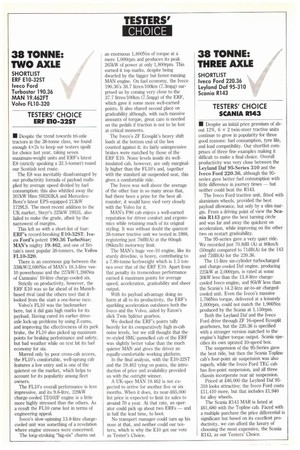38 TONNE: TWO AXLE
Page 34

If you've noticed an error in this article please click here to report it so we can fix it.
SHORT LIST ERF E10-32ST Iveco Ford Turbostar 190.36 MAN 19.462FT Volvo FL10-320
TESTERS' CHOICE ERF E10-32ST
• Despite the trend towards tri-axle tractors in the 38-tonne class, we found enough 4x2s to keep our testers spoilt for choice last year, taking seven maximum-weight units and ERF's latest E8 (strictly speaking a 32.5-tonner) round our Scottish test route.
The E8 was inevitably disadvantaged by our productivity formula of payload multiplied by average speed divided by fuel consumption: this also whittled away the 207kW Him SH283KA and MercedesBenz's latest EPS-equipped 213kW 1729LS. The most recent addition to the UK market, Steyr's 225kW 19S31, also failed to make the grade, albeit by the narrowest of margins.
This left us with a short-list of four: ERF's record-breaking E10-32ST: blew Ford's potent 190.36 TurboStar; MAN's mighty 19.462, and one of Britain's most popular 38-tonners, the Volvo FL10-320.
There is an enormous gap between the 338kW/2,080Nm of MAN's 18.3-litre vee10 powerhouse and the 227kW/1,288Nm of Cummins' 10-litre charge-cooled six.
Strictly on productivity, however, the ERF El0 was so far ahead of its Munichbased rival (and the others too) that it looked from the start a one-horse race.
Volvo's FL10 was the backmarker here, but it did gain high marks for its payload. Having cured its earlier driveaxle lock-up problems by using Z-cams, and improving the effectiveness of its park brake, the FL10 also picked up maximum points for braking performance and safety, but bad weather while on test hit its fuel economy for six.
Marred only by poor cross-cab access, the FL10's comfortable, well-sprung cab features a low entry and is one of the quietest on the market, which helps to account for its popularity among fleet owners.
The FL10's overall performance is less impressive, and its 9.6-litre, 229kW charge-cooled TD102F engine is a little more highly stressed than the others. As a result the FL10 came last in terms of engineering appeal.
Iveco's slow-spinning 13.8-litre chargecooled unit was something of a revelation where engine stresses were concerned.
The long-stroking "big-six" churns out an enormous 1,800Nm of torque at a mere 1,000rpm and produces its peak 265kW of power at only 1,800rpm. This earned it top marks, despite being dwarfed by the bigger but faster-running MAN engine. On fuel economy, the Iveco 190.36's 38.7 litres/100km (7.3mpg) surprised us by coming very close to the 37.7 litres/100km (7.5mpg) of the ERF, which gave it some more well-earned points. It also shared second place on gradeability although, with such massive amounts of torque, great care is needed on the pedals if traction is not to be lost at critical moments.
The Iveco's ZF Ecosplit's heavy shift loads at the bottom end of the box counted against it; its fairly unimpressive brakes were matched by those of the ERF E10. Noise levels inside its wellinsulated cab, however, are only marginally higher than the FL10's and, together with the standard air-suspended seat, this gives a comfortable ride.
The Iveco was well above the average of the other four in so many areas that, had there been a prize for the best allrounder, it would have vied very closely with the Volvo for it.
MAN's F90 cab enjoys a well-earned reputation for driver comfort and ergonomics while retaining much of its original styling. It was without doubt the quietest 38-tonner tractive unit we tested in 1988, registering just 70dB(A) at the 60mph (96km/h) motorway limit.
The MAN's huge vee-10 engine, like its sturdy driveline, is heavy, contributing to a 7.80-tonne kerbweight which is 1.5 tonnes over that of the ERF E10. Apart from that penalty its tremendous performance earned it maximum points for average speed, acceleration, gradeability and sheer output.
With its payload advantage doing no harm at all to its productivity, the ERF's sparkling acceleration outshines both the Iveco and the Volvo, aided by Eaton's slick Twin Splitter gearbox.
We docked the ERF's points tally heavily for its comparatively high in-cab noise levels, but we still thought that the re-styled SMC-pannelled cab of the ERF was slightly better value than the much quieter MAN and gives the driver an equally-comfortable working platform.
In the final analysis, with the E10-32ST and the 19.462 tying on points, the introduction of price and availability provided us with the outright winner.
A UK-spec MAN 19.462 is not expected to arrive for another five or six months. When it does, its near465,000 list price is expected to limit its sales to around 70 a year. At that rate, an operator could pick up about two ERFs — and in half the lead time, to boot.
No transport manager could turn up his nose at that, and neither could our testers, which is why the El0 got our vote as Tester's Choice.
































































































